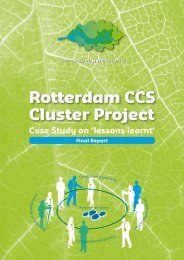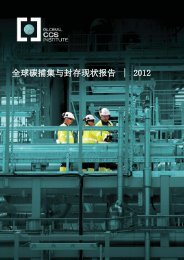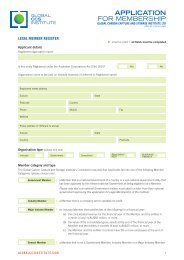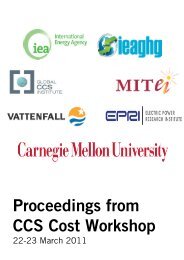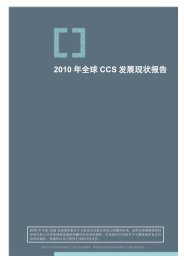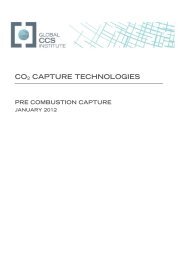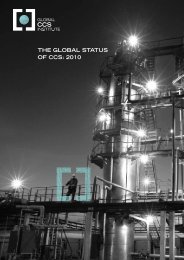Perceptions of CO2 Report - Global CCS Institute
Perceptions of CO2 Report - Global CCS Institute
Perceptions of CO2 Report - Global CCS Institute
- No tags were found...
Create successful ePaper yourself
Turn your PDF publications into a flip-book with our unique Google optimized e-Paper software.
Recommendations derived from this work may be summarised as follows:• Efforts to promote dialog and understanding about <strong>CCS</strong> should incorporateinformation on CO 2 ’s properties and chemistry. Research found a limited knowledgebase among respondents. In the absence <strong>of</strong> such knowledge, members <strong>of</strong> the public maybe unclear on how to perceive CO 2 , and may subscribe to a variety <strong>of</strong> mistaken beliefs.• Balanced and complete information on CO 2 ’s properties should be made available.When communicating this information, it is important to include CO 2 ’s effects on humansand the environment (e.g., potential for soot-like effects and toxicity). Information regardingCO 2 ’s scientific and chemical properties was shown to have a weak but significant positiveeffect on <strong>CCS</strong> perceptions.• Topics deemed important by respondents should be addressed by communicators.The variation <strong>of</strong> reactions, anxieties, and beliefs amongst respondents highlighted theimportance <strong>of</strong> accounting for these in communication and education efforts regarding CO 2and <strong>CCS</strong>. Any effort to engage in dialogue with the public regarding <strong>CCS</strong> should be basedon an inventory and understanding <strong>of</strong> public levels <strong>of</strong> knowledge and information needs.This information can be collected through a baseline survey, as described in theCommunication/Engagement toolkit for <strong>CCS</strong> projects (Ashworth et al. 2011a).• Care should be taken in describing CO 2 natural phenomena. It is important to presentopen and transparent information, such as on incidents during which naturally-occurringCO 2 has harmed people, plants, and animals (i.e., the Lake Nyos 4 and Mount Mammoth 5events). Information on natural phenomena involving CO 2 had a weak but significantnegative effect on <strong>CCS</strong> perceptions, suggesting that people use these descriptions <strong>of</strong>natural phenomena to make inferences about <strong>CCS</strong>, CO 2 and its effects.• Care should be taken in describing the behaviour <strong>of</strong> CO 2 in the <strong>CCS</strong> process.Conveying correct and complete information on CO 2 ’s behaviour is important because thisunderstanding will be helpful to mitigate misunderstandings that can arise whenrespondents receive incomplete or indirect information about <strong>CCS</strong>.• Many members <strong>of</strong> the public still require basic information on climate change, <strong>CCS</strong>,and their relationship to CO 2 emissions. Awareness <strong>of</strong> these topics does not directlyimply knowledge, as for example, more participants indicated having heard <strong>of</strong> <strong>CCS</strong> than didactually understanding what it is.• Additional <strong>CCS</strong> education and outreach campaigns should be planned through lessformalmechanisms. Given that the correlation between trust in informal sources andpoorer understanding <strong>of</strong> <strong>CCS</strong>, sole reliance on the formal information and communicationsources (i.e., public sector organisations, local government, national newspapers, andscientists) may not reach the people with the poorest understanding <strong>of</strong> <strong>CCS</strong>, who insteadplace their trust in NGOs, friends, and the internet.4 In 1986, naturally-occurring CO 2 was released from Lake Nyos in Cameroon, killing animals and 1,700 people.5 At the Mount Mammoth volcano in the United States, a large volume <strong>of</strong> <strong>CO2</strong> seeping from underground has been killing trees.viii | Understanding how individuals perceive carbon dioxide




